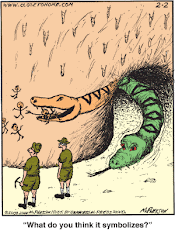Today we’ll take on “Don’t Ask, Don’t Tell” (DADT); this because the Pentagon’s top leadership just came out and reported that revocation of the policy, following a period of preparation, would be their preferred way to go.
There will be lots of others who will take on the question of what’s right and wrong here, and exactly how implementation might occur; my interest is, instead, to focus on one little fact that makes all teh rest of the conversation a lot more relevant.

That is the fact that about 70,000 LBGT troops serve in the military today, DADT notwithstanding, and, that if it wasn’t for DADT, almost 45,000 more troops would be serving that aren’t today.
And that one little fact leads to today’s Great Big Question: exactly how much military would 115,000 troops be, exactly?
“Dad, if I were you, I wouldn’t tell that story. Now I have no doubt that there might be a lot of truth in it, but you know how funny these people are. You know you always used to tell us when we were children: “Never smarten up a chump.”
--“Victoria Whipsnade”, to her father, “Larson E. Whipsnade”, in W.C. Field’s “You Can’t Cheat an Honest Man”
As we so often do, let’s set a stage: we use the 115,000 figure because we have the academic work of UCLA’s Gary J. Gates informing our estimate, and that estimate was updated in May of 2010.
A stage having been set, let’s move on to painting some pictures:
These days the Army organizes themselves around Brigade Combat Teams (BCT), and a BCT might normally be assigned somewhere between 2500 and 4000 soldiers, and 115,000 troops could equal more than 30 BCTs.
It appears that more or less 12 BCTs and two more Combat Aviation Brigades are on the ground in Iraq today, which works out to about 49,000 troops in total...and that means 115,000 LBGT troopers could theoretically fill every billet in Iraq, and then replace themselves after a year, with about 15,000 left over.
The Navy is organized around Carrier Strike Groups, which each consist of one of the 12 aircraft carriers now in service and the additional ships they require to complete their missions.
Those aircraft carriers require crew to operate the ship’s basic equipment, Marines who provide security and other functions, additional crew to operate the “Air Wing”, which is the organization on board responsible for flight operations, and, because carriers also serve as the “traveling headquarters” for the Admiral who is commanding the Strike Group, a few more crew to serve as the Admiral’s personal staff.
Add it all up, and a carrier can have a crew of almost 6,000 on board...and that means there are enough LBGT forces available to occupy every bunk on every carrier in the Navy, from the actual bed in the Admirals’ Cabin all the way down to the “stacks of racks” way down belowdecks for the ordinary Sailors and Marines.
Even beyond that, there would be enough people left over to crew every one of the Navy’s 100 or so submarines—and you’d still have about 30,000 sailors left over to maintain the ships and their associated aircraft when they return to port.
The Air Force, as with the other Services, is composed of components drawn from Active Duty, Reserve, and National Guard forces. As it turns out, the entire Air National Guard is 106,700 strong. Our 115,000 LBGT troopers could fill every one of those slots—and that would still leave enough personnel to completely fill the Air Force’s pilot training schools for seven years after that.
The Marine Corps’ fighting forces are designed to work with the Navy to combine a variety of capabilities into self-sustained “over the beach” units that can, if required, take and hold beaches, ports, or airfields, or build a base of their own and hold it, until a larger force can come in and expand the foothold, so to speak. (The Corps refers to one of these units as a “Marine Expeditionary Force”, or an MEF.)
To provide this capability worldwide, the Corps maintains three MEFs, one on the East Coast, one on the West Coast, and one stationed in the Pacific, based in the Hawaiian Islands and Guam.
115,000 Marines would equal almost half of the entire Corps, Active Duty and Reserve, and that’s more troops than two of the MEFs combined, which might typically comprise 45,000 Marines each, more or less...which means if the LBGT Marines needed to, they could most assuredly take and hold some serious real estate, more or less anywhere in the world—and if they ran into trouble, they could send back home for another 25,000 more LBGT troops to help make their point.
So there you go: the next time someone’s talking about how much national security might be threatened if we change DADT, you can tell them that there’s a cost to national security from keeping DADT as well.
How much of a cost? If you pulled those 115,000 potentially affected troops from the Army, DADT could cost us two Iraqs worth of troops, with 15,000 reinforcements left over, and if it was just the Navy, it could affect enough sailors to crew every aircraft carrier and submarine and 30,000 more besides.
If you removed that many personnel from the Air Force it would affect more people than the entire Air National Guard and seven years’ worth of new pilots combined—or, if you prefer to look at it through the prism of a eagle, globe and anchor, it could be enough LBGT Marines to take and hold darn near anything, from the halls of Montezuma, to at least somewhere near the shores of Tripoli.
I don’t want to pay that price, and apparently the Secretary of Defense and the Chairman of the Joint Chiefs of Staff don’t either...so hey, John Mc Cain...why don’t we just get over this imaginary Great Big Deal and move on to some real ones?

No comments:
Post a Comment